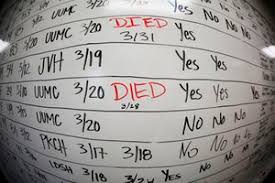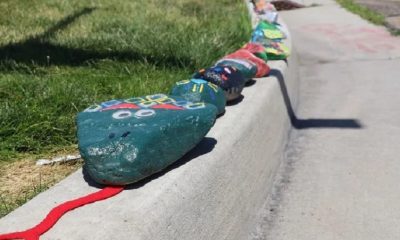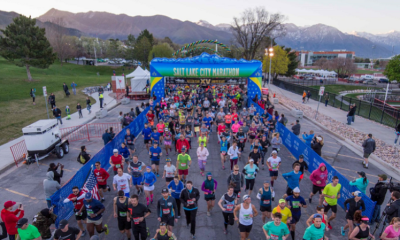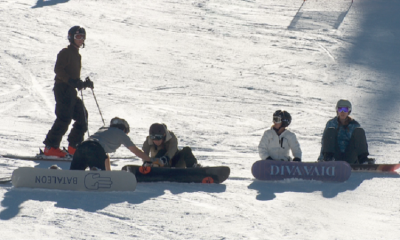Covid-19
New COVID-19 cases in Utah drop back below 1,000 following Friday peak

SALT LAKE CITY — The number of newly confirmed cases of COVID-19 dipped slightly in Utah Sunday to 920, the Utah Department of Health reported.
Daily infection numbers peaked Friday with 1,117 new cases and dropped to 1,077 Saturday. No new deaths were reported Sunday.
The continued small decline in cases comes as Corner Canyon High School career and technical education teacher Charri Jensen, who tested positive amid an outbreak at her school of at least 70 cases in the past two weeks, remained hospitalized on Sunday, her birthday. Her family reported that her condition had improved from a day earlier.
“We just got off the phone with the doctor and mama is sure fighting,” Jensen’s daughter Talesha Jensen wrote in a text to the Deseret News Sunday. “All her vitals are still looking good and they said that most COVID patients as sick as her have to have medication to keep their blood pressure good and she’s doing that 100% on her own.”
Meanwhile, Talesha Jensen, her father and sister are recovering from COVID-19 at home, she said.
“I’m all right, just ready for her to be home. I’m missing her a lot today,” Jensen said.
She urged Utahns, in the face of record numbers of new cases in recent days, to “just follow all the (public health) guidelines and listen to your body. We need to take things more seriously because things are getting out of hand. I know everyone wants to get back to normal life but I would rather stay in my house quarantined if I could just have my mom better. I would do anything and I don’t want anyone else to feel this pain,” she said.
Statewide, the health department has recorded 75 outbreaks in schools that resulted in 465 confirmed cases. Those who tested positive in the school outbreaks — defined as two or more cases outside of a household within two weeks — had a median age of 16 years old, according to figures on the health department’s website.
So far, the disease caused by the novel coronavirus has claimed 440 lives in Utah.
While a handful of neighborhoods on the west side of the Salt Lake Valley — including West Valley City, Rose Park and Glendale — remained hot spots, other clusters with a positive rate of more than 4,000 per 100,000 residents are found in Provo and Orem.
Utah County has played a large role in the statewide increase, the health department said last week. Its data shows cases there quadrupled from about 100 a day in mid-August to nearly 400 earlier this week.
Gov. Gary Herbert on Saturday renewed the State of Emergency declaration, allowing him to continue to take certain executive actions relating to COVID-19. The order remains in effect through Oct. 20.
COVID-19 has infected 63,772 residents to date. Since Saturday, another 6,215 people were tested, the health department said. The rolling seven-day average for new cases is now 835 per day — up from 796 a day earlier — with a 13.1% positive rate.
Currently, 141 people are being treated in hospitals for COVID-19, four more than a day earlier. Since the beginning of the outbreak, 3,494 cases have required hospitalization.
A total of 51,410 Utahns are considered to have recovered, meaning they had not succumbed to the illness within three weeks of a diagnosis.
Reconfiguring the symphony stage
The pandemic has largely paused live performances, but the Utah Symphony is finding its way to a new normal with help from a pair of experts in air flow at the University of Utah.
Two chemical engineering researchers have hashed out a series of potential tweaks at Abravanel Hall that they found could reduce the potential concentration of the virus on stage by more than a hundred times, allowing those who play wind instruments to return to the stage and still minimize any risk to fellow musicians, patrons or employees.
While violinists and percussionists can sport masks, those playing flute, trumpet or clarinet don’t have that option.
James Sutherland and Tony Saad measured air flow rates in the building and analyzed data tied to different wind instruments, creating simulations that helped inform a series of recommendations they presented to the musicians last week.
They include divvying up trumpet players, for example, placing them by doors that draw air flow outside and vents directing the air out of the stage area and away from colleagues who can’t wear masks and play at the same time. Some of the air will still circulate nearby, but around performers who can wear masks and maintain several feet of distance.
“By moving the potential emitters, the potential infectors, closer to the vents and the doors, we flush out any potentially loaded particles immediately,” Saad said. “And that’s what you want.”
The researchers used powerful computers for their analysis, which would have taken 57 years if they had just one on hand, Saad said.
In their discussions with conductor Thierry Fischer and others at the symphony, the researchers said they learned it is prioritizing safety over potential changes to sound and tradition, part of a larger plan with both audience and the musicians in mind.
“It was really heartening to see how enthusiastic they were about getting back to playing and doing so safely, and considering our recommendations in order to accomplish that,” Sutherland said.
They’re doing a similar analysis for the Capitol Theatre ahead of the upcoming season of the Utah Opera.
-

 Local News7 days ago
Local News7 days agoThe Draper rock snake outgrows its house and makes its way to Utah Arts Alliance
-

 Local News2 weeks ago
Local News2 weeks agoA large number of people start running in the Salt Lake City Marathon
-

 Local News2 weeks ago
Local News2 weeks agoUsing a deck of cards, a Utah man hopes to overcome his fear of flying
-

 Local News2 weeks ago
Local News2 weeks agoStarting this Saturday, National Park Week will begin with free park access
-

 Local News1 week ago
Local News1 week agoProcedure for securely bringing prisoners from Utah to court
-

 Local News2 weeks ago
Local News2 weeks agoDuring the 2022–2023 season, Utah’s ski industry brought in $1.94 billion in revenue from non-resident visitors
-

 Local News2 weeks ago
Local News2 weeks agoAll downtown companies should benefit from the rising wave of the Utah NHL
-

 Local News1 week ago
Local News1 week agoTwo more names are added to the Utah NHL team’s trademark list






Leave a Reply